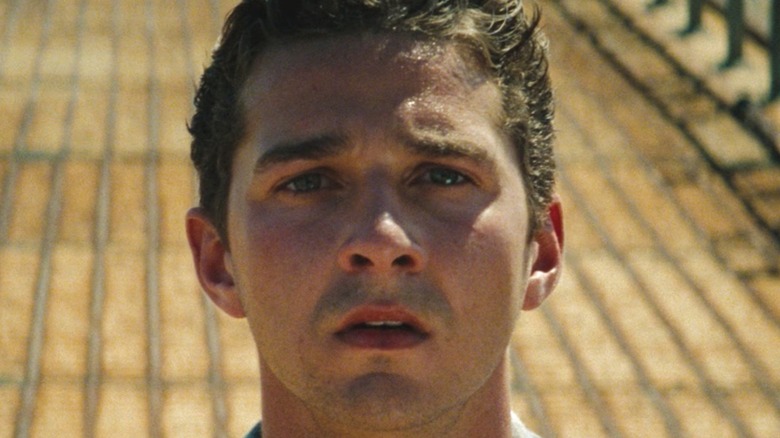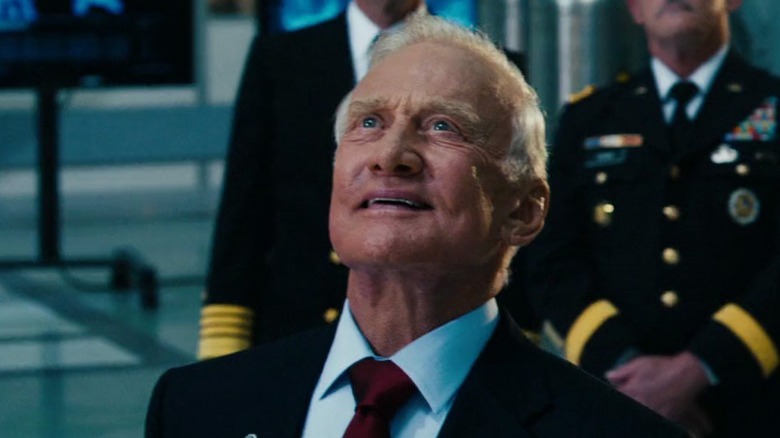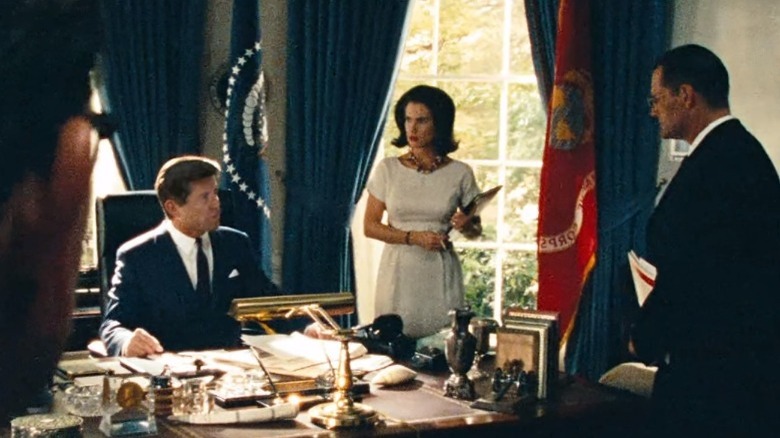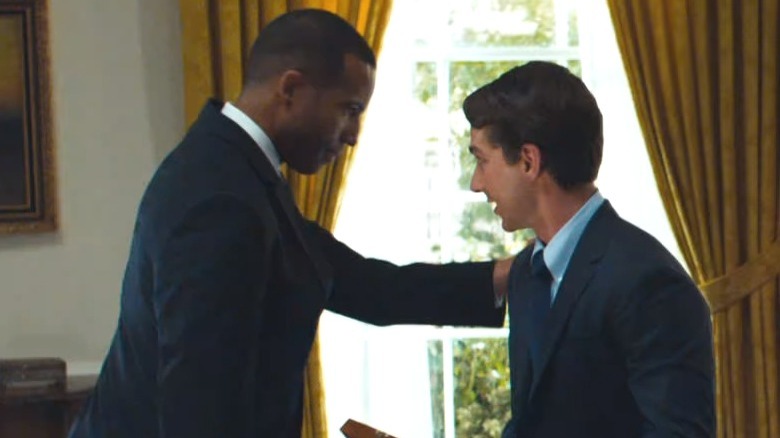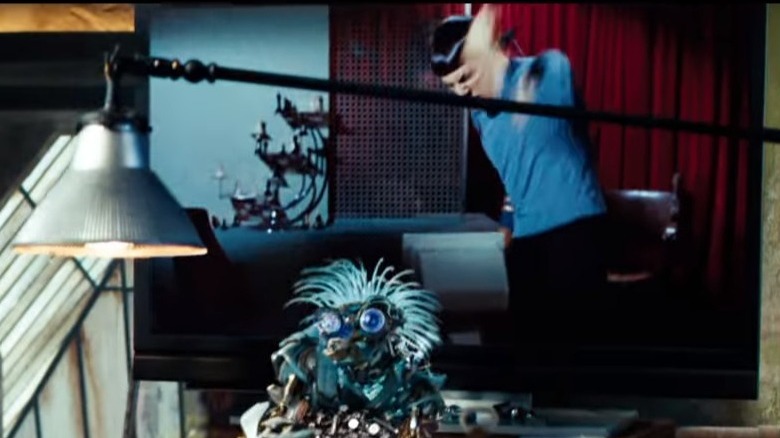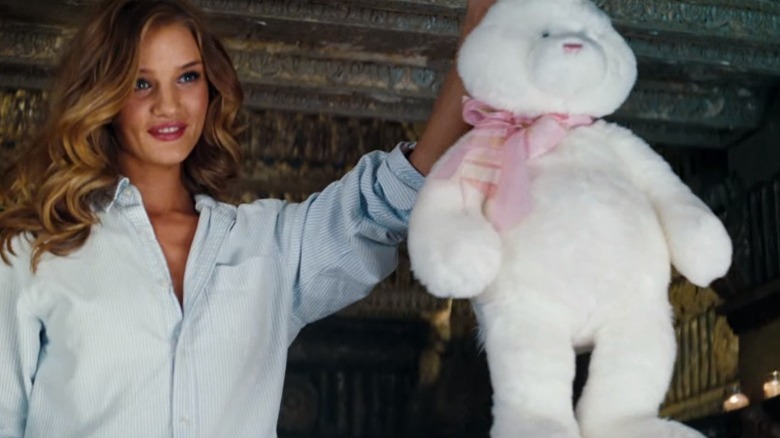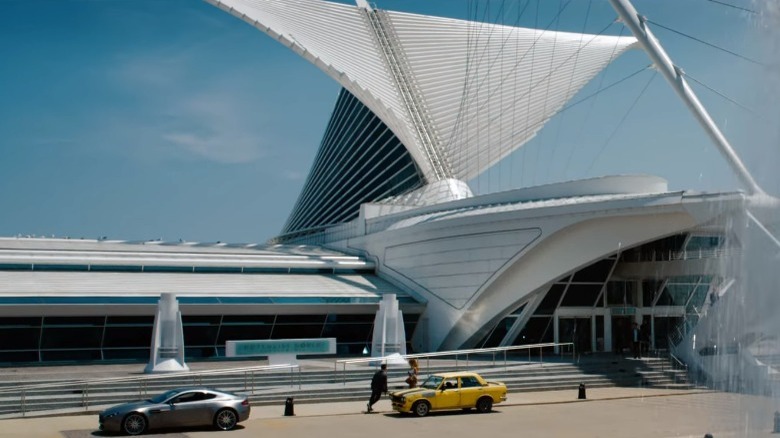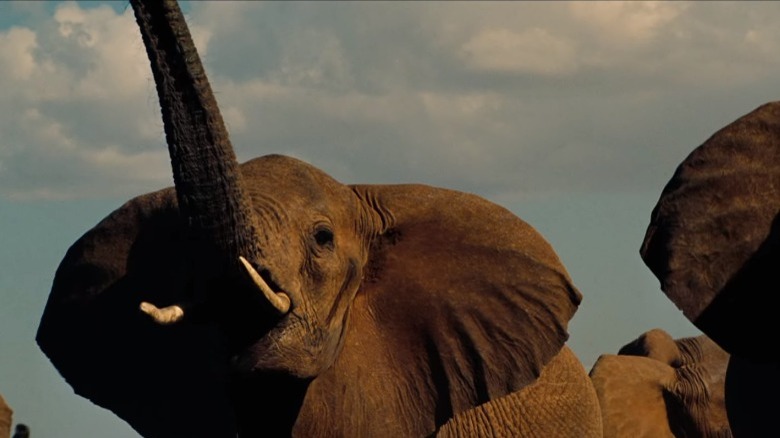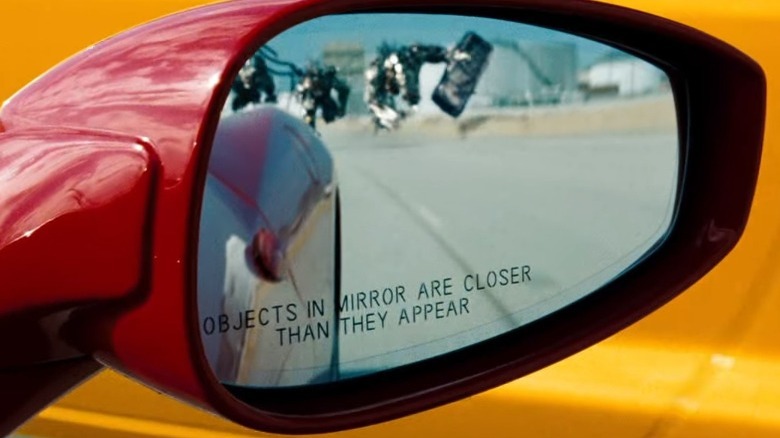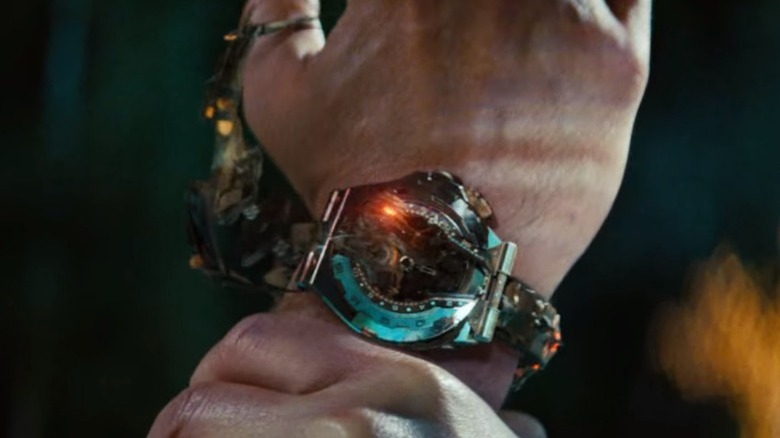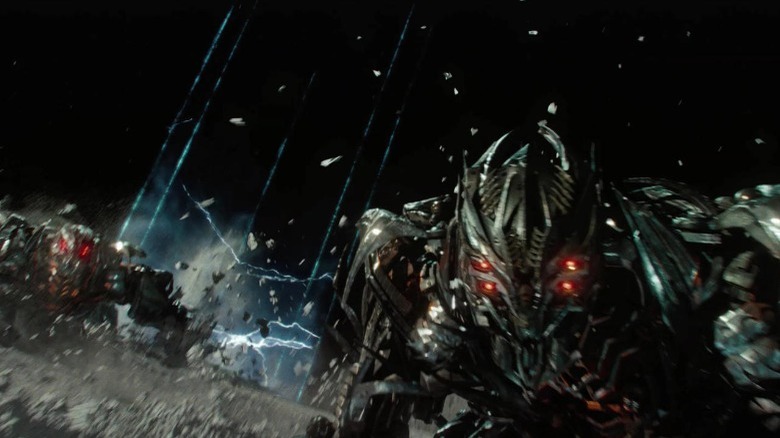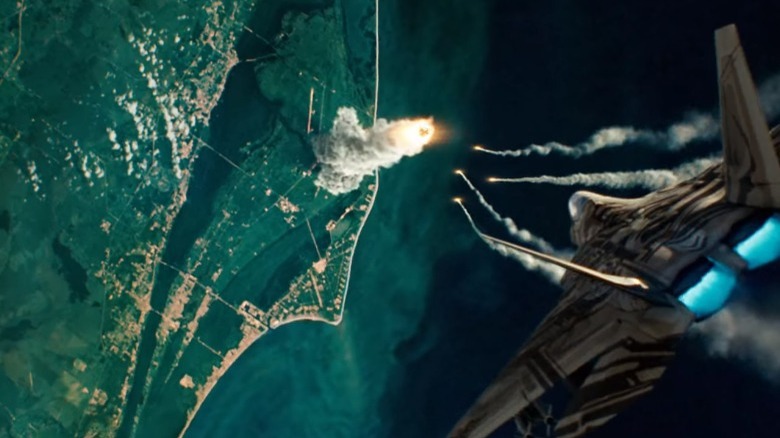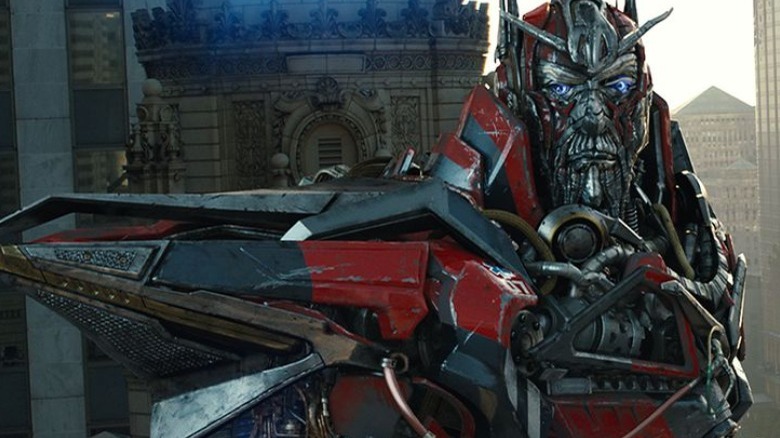Small Details You Missed In Transformers: Dark Of The Moon
The "Transformers" movie franchise is a testament to the enduring appeal of the popcorn movie. The second movie "Revenge of the Fallen" made even more money than the first, and the third installment "Transformers: Dark of the Moon" was even more popular still, making over a billion dollars despite reshuffling the cast, retconning much of the existing story, and generally being kind of incoherent. Like more or less every Michael Bay movie, "Dark of the Moon" exists in a pure movie-going world that's immune to a harsh critical consensus, especially after two other installments. As long as a lot of stuff blows up, "Transformers" movies are guaranteed to deliver.
Shia LaBeouf made his third and final turn as our everyman in "Dark of the Moon," surrounded by a deep cast of comedic ringers like Kevin Dunn, John Turturro, and Alan Tudyk. Let's revisit the third of what will soon be a seven movie franchise, and see what we missed between explosions and the suspension of disbelief. Here are some small details about "Transformers: Dark of the Moon" you may have missed.
The movie retcons the entire Space Race
The "Transformers" movies exist in a world that is generally pro-military and by extension pro-government— at the beginning of "Dark of the Moon," the Autobots have been working in conjunction with NEST, a human global joint task force, to keep the world safe from Decepticons. But amidst all the admiration for special ops weaponry, as well as shiny shots of domestic and foreign car product placement, "Dark of the Moon" slips a big idea into its exposition that qualifies the movie as a deep, cynical satire when you really think about it: it trivializes the space race and the Cold War in a single breath.
In the movie's version of 1961, a Cybertron UFO crashes into the dark side of the moon (although it seems the words "the" and "side" didn't make the cut for the movie title), and this event is shown to be the primary motivation for President John F. Kennedy to make his famous "we choose to go to the moon" speech in 1962. It wasn't American exceptionalism, and it wasn't our supposed ideological struggle with Russia for the soul of the world. In "Dark of the Moon," we just wanted to get our greedy hands on alien tech before anybody else could. Somehow the movie even got the real Buzz Aldrin to cameo as himself, and have an entire discussion with Optimus Prime (Peter Cullen) about how the fictional Apollo 11 mission involved scouting an alien ship, and then lying to the American public about it for the next 50 years.
Jackie O in the Oval Office?
"Transformers: Dark of the Moon" presents its alternate history of the space race all in a rush, with some creative use of voice-over and footage made digitally grainy of some stand-ins. But they moment that the movie's JFK learns about the alien ship on the moon, he's joined by another familiar looking figure in the Oval Office: is that First lady Jackie Kennedy? Unless we've been seriously mislead about Jackie O's role in the Kennedy administration, it seems odd that she'd be privy to such a top-level secret.
Even if it's just a secretary that styles her hair in a similar way to Jackie's iconic bouffant, it betrays a real casual attitude about classified information. We see later that the existence of the alien craft is kept secret to the majority of NASA itself during the Apollo missions. When you're delivering confirmation to the President that we're definitively not alone in the universe, you have at least think to clear the room first.
The Obama stand-in
"Transformers: Dark of the Moon" came out while Barack Obama was in office — still in his first term, in fact. It's understandable that they couldn't snag the president himself to appear in a brief scene when Sam receives a medal for his heroism in the previous two movies. But "Dark of the Moon" makes it pretty hard to miss that the stand-in they have for Obama for just a split second bears only the slightest resemblance to the real thing.
It would be jarring enough on its own, but the movie presents it as a flashback just seconds after Sam holds up a picture of him and the real Obama during the medal ceremony. The juxtaposition of the actual president's image and the clearly fake body double really highlights the artificiality of the approach. "Dark of the Moon" might have been better served creating its own fictional president, since it ending up casting one anyway.
A shout out to Leonard Nimoy's other sci fi role
"Transformers: Dark of the Moon" really got to have its cake and eat it too, in a sense. Not only were Michael Bay and company lucky enough to land the iconic Leonard Nimoy in the key role of Sentinel Prime, since he was only doing voice over work they could still set the movie in a world where "Star Trek" existed without causing any confusion. In early scene, well before Sentinel is revived, Wheelie (Tom Kenny) and Brains (Reno Wilson) are watching an old "Star Trek: The Original Series" episode on the couch.
In a very straight ahead bit of foreshadowing, they're watch the Season 2 "Star Trek" premiere "Amok Time," or as Wheelie puts it "the one where Spock goes nuts." Sentinel will eventually reveal himself to be working with Megatron (Hugo Weaving), although the parallels to Spock end there: the episode gets deep into Vulcan mating habits and the ritual of "pon farr."
"Trek" references are a bit of recurring theme for the rest of "Dark of the Moon," most notably when Same compares the futuristic home of billionaire Dylan Gould (Patrick Dempsey) to "the star ship Enterprise."
The slow reveal that Megan Fox isn't in the movie
As the years go on, we've been reevaluating the career of Megan Fox, who was propelled to breakout success in "Transformers" and "Transformers: Revenge of the Fallen" before departing the franchise under mildly controversial circumstances. With "Jennifer's Body" growing into a sleeper cult hit that perhaps just had terrible marketing and her well-received guest arc on "New Girl," Megan Fox has proven her merit as a comedic actress, and in retrospect her performance in the early "Transformers" movies is kind of impressive in light of how little direction she likely got.
In 2011, with perhaps a bit of sly bitterness about Fox's departure, "Dark of the Moon" has a little bit of fun introducing Sam's new love interest Carly (Rosie Huntington-Whitely). In a long, indulgent tracking shot that follows Carly up the stairs from behind, we don't see her face until the very last moment, framed and scored in a sort of "surprise" moment as if to say "whoops! It's not Mikaela after all, it's another supermodel that Sam is very nervous about being out of his depth with. Have no fear, the status quo always reigns in the 'Transformers' franchise."
Dylan's house is a real building
"Transformers: Dark of the Moon" really pulls out all the stops to let us know that Carly's boss Dylan is one of the wealthiest fictional characters imaginable. He owns so many luxury cars that he gives one to Sam and Carly like it's nothing, and he lives an all-white, futuristic building that Sam compares to a spaceship. It has sleek and curved white interiors like a sci fi whale skeleton, and is topped by a conical structure with magnificent "brise soleil," essentially wings that stretch out from the roof to block sunlight. It's a structure that causes double takes to look at, that you might suspect is computer generated.
It is in fact the Milwaukee Art Museum, and the distinctive design by architect Santiago Calatrava quickly became the city's most recognizable landmark when completed in 2001. "Dark of the Moon," filming in Milwaukee in front of excited crowds for a few days in 2010, used the postage-stamp pride of an entire Midwestern city to stand in for the home of a rich villain.
All hail Megatron, even elephants
A brief moment in "Transformers: Dark of the Moon" when we finally reconnect with Megatron turns out to be one of it's unintentionally funniest. Apparently having just completed a long ride in truck-form across the African desert, Megatron transforms into Decepticon mode and startles a herd of zebras and a herd of elephants in doing so. He says aloud "All hail Megatron!"
But is he speaking to himself? Was he speaking to the elephants and zebras in a display of "Doolittle" skills we didn't know about? Maybe this will tie in to the upcoming "Transformers: Rise of the Beasts" in some way, which much like "Bumblebee" is a prequel to all of the events of the rest of the "Transformers" movies. It's possible this is just a clunky edit, since the next shot is Megatron approach a camp of his Decepticon lackeys for an update on their nefarious schemes, but it really appears like Megatron expects the elephants to bow down and salute him for a second.
A Jurassic Park mirror homage
While we all know Steven Spielberg primarily as a director, he's also a prolific producer of other people's movies, and in fact is an executive producer on every "Transformers" movie. "Dark of the Moon," likely with his blessing, includes a quick shot that contains a visual homage to a shot in his revolutionary blockbuster "Jurassic Park."
During a chaotic freeway chase sequence, a Michael Bay staple, there's a quick glimpse of some rampaging Decepticons through Bumblebee's side-view mirror, which has the standard disclaimer that "objects in mirror may be closer than they appear." Just like the shot of a Tyrannous Rex in a Jeep side-view mirror in Spielberg's masterpiece a couple decades earlier, the mirror's disclaimer reads like a punchline during a hectic chase sequence. "Transformers" does the subtlest of hat tips toward a franchise that walked so it could run in terms of CGI spectacle.
Why doesn't the spy-watch set off alarms?
Granted, "Transformers: Dark of the Moon" isn't the kind of movie that stands up to nitpicking. But even in the spirit of shutting our brains off and going with the flow, "Dark of the Moon" doubles back on its own logic often enough with little things that we can't help but question. Much of the status quo of the movie's partnership between the Autobots and World Forces involve the use of ubiquitous "Energon detectors" that go off whenever any Cybertron tech is around. This is why, to set the first several parts of their plan in motion, the Decepticons have blackmailed or otherwise coerced humans into doing their bidding.
But when Dylan reveals himself to have been working for the Decepticons (since birth, essentially) and plants a bit of Decepticon tech on Sam in the form of a nervous-system hijacking wristwatch to spy on the Autobots, it easily gets past all the Energon detectors without any issue. After the first half of the movie essentially relied on their infallibility, they don't make a peep when there's unauthorized Cybertron tech right next to the Director of National Intelligence on a secret base.
Why didn't the Decepticons on the moon fight in the last two movies?
A common question for every kind of sequel: do you need to see the other movies first to understand it? The way that the "Transformers" series works, not only do you not really need to see the earlier movies, it might actively hinder your understanding of what's going on to try and keep it all together. Just as "Revenge of the Fallen" introduced ancient members of the Autobots and Decepticons that apparently just stayed hidden on Earth during the events of "Transformers," "Dark of the Moon" is rife with inevitably questions of why none of this new ancient history regarding Sentinel Prime, the pillars, and the Ark had never come up before.
The biggest kicker is the late-movie revelation that leagues of additional Decepticons have been buried on the moon this entire time. Maybe this had something to do with whatever reason Megatron and Sentinel Prime had for meeting on Earth during the Great War, but they certainly don't manage to mention it at any point. Where were these Decepticons when their friends lost out to the Autobots twice during the last two films? When did they get to the moon?
The Autobots fake their deaths for no reason
"Transformers: Dark of the Moon" slows down halfway through for a strange and hard to believe plot twist. On the strength of pretty much just one voicemail from Sentinel Prime, the nations of the world agree to collectively turn on the Autobots and banish them to space. We know as the audience that the primary heroes of the movie aren't just going to disappear for good halfway through, but they all say goodbye to Sam and board a space shuttle anyway, only to apparently get destroyed by Starscream (Charlie Adler).
When the Autobots inevitably reveal they faked their own deaths, subsequent events immediately prove the whole thing to be an entirely pointless subplot. To really let human learn how much they needed them, the Autobots just hid out while the city of Chicago was taken over, and hundreds (perhaps thousands) of people are killed. All of this allegedly buys them the element of surprise over the Decepticons, which they give away in minutes when Bumblebee and Sam resuce Carly as a first order of business. Countless lives and lots of time could have been saved if the Autobots just said "hey, probably don't trust the message from Sentinel Prime? Remember how he just announced he was a traitor and killed Ironhide (Jess Harnell) and a bunch of soliders? That was, like, yesterday."
Sentinel Prime's logic makes no sense
The writers of "Transformers: Dark of the Moon" couldn't resist one final "Star Trek" reference in the closing moments of the movie. In classic taunting villain fashion, Sentinel Prime says he pities the Autobots, who have just never understood that "the needs of the many outweigh the needs of the few." This is of course an exact quote of Leonard Nimoy's Spock in "The Wrath of Khan," setting up a noble sacrifice from the pivotal moments late in the second "Star Trek" movie.
It's a fun geek moment, but as a rationale for Sentinel Prime's behavior, it makes absolutely no sense. He's actually planning on the exact opposite: he's willing to enslave several billion humans to rebuild Cybertron, in order to preserve the civilization of just a handful of Decepticons that have survived. It seems entirely possible that the screenwriters meant to invert the line to be "the needs of the few outweigh the needs of the many," but that's not what the script ultimately said.
